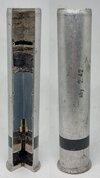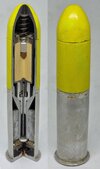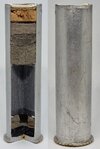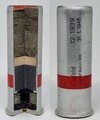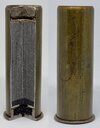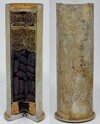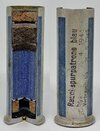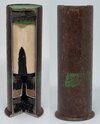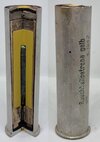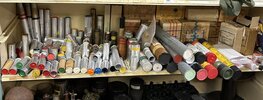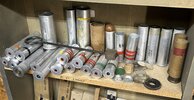pzgr40
Well-Known Member
Last April I bought this nice German signal Gun on a collectors meeting in the Netherlands. I allready had two interesting catridges, the ‘2,6cm Wurfgranatpatrone 326 LP’ (9), and the ‘Fallschirmpatrone fur windmessung’ (1). As both cartridges are allready described on this forum I will place the link only to the postings.
As I -suddenly- found this an interesting subject I bought another thirteen German WW2 calibre 4 cartridges for this gun and changed them all into cutaway models. The pyrotechnic charges have been measured and replicated with coloured polyurethane staff. With some cartridges I replicated the original colours of the internals as to stay as close to what one would see when cut (4,7,8,9,10,11,12,13,14,15), with the others I used didactic colours as to represent the colours of the light emited (2,3,5,6).
The usage of pyrotechnic means for signalling is as old as the use of gunpowder and the rocket. Signaling cartridges Caliber 4 (26,5mm dia) as described below were taken into service in 1894 by the German army, and are still in use even today in many countries.
The use of signal cartridges precedes the time that radios, walkie talkies and phones were used on the battlefield, and a message had to be conveyed to a large group of people. Disadvantage of the use of signal cartridges is that one has to agree in advance on what order a (sound or light) signal means and what other signal ends the order. As it took the enemy a short time to figure out what a certain signal meant, the meaning of a signal had to chance per day, and all own troops needed to know this in advance. A story I read on the internet about what happens if this communication fails was about a German unit on the eastern front that requested to stop artillery support as this accidentaly fell short on their own troops. A red flare was launched, supposing to meaning ‘stop artillery support’, however, this was yesterdays signal, on this day a red flare meant increase artillery support. An expensive mistake.
Flares were also used when radio silence was practiced (at sea for instance) to prevent giving away position.
The German army has designed and used an enormous variarity of functions for Caliber 4 cartridges, other countries just used the signal cartridges for battlefield illumination and signalling stars.
Not described here is the civilian usage of signal cartridges for rescue at sea or aviation, however there will be an overlap with military cartridges with some types of cartridges.
All cartridges describes below here are German cartridges from WW2.
1 - https://www.bocn.co.uk/threads/fallschirmpatrone-für-windmessung.108962/
2 - The ‘Fallschirmleuchtpatrone’ or ‘Flare cartridge with parachute’. This cartridge was meant to illuminate the battlefield. The Flare and the parachute are placed in an aluminium bushing which has a pyrotechnic fuze and an expulsion charge in the base. The flare is placed in brown packing paper glued to the flare. A cartboard disc with a staple is glued to the top of the flare, a chain with the parachute is is linked to the staple.
After firing, the pyrotechnic delay expires and ignites the expulsion charge, and the aluminium bushing ejects the flare at approximately 40 meter high, launching the ignited flare to 80 height, opening the parachute by means of the windstream. The flare burns for approximately 15 seconds, emitting bright white light.
Headwinds had to be taken into account to prevent the flare from being driven by the wind over one's own position and illuminating one's own position.
The cartridge was produced by ORION, which is ORION metallwarenfabik GmbH Kremmen/Mark.
3 - The ‘Fallschirmlsignalpatrone rot’ or ‘Signal flare cartridge with parachute red’ This cartridge was nearly identical in build up to the ‘Flare cartridge with parachute’ (02). The Flare and the parachute are placed in an aluminium bushing which has a pyrotechnic fuze and an expulsion charge in the base. The flare is placed in an aluminium bushing. A cartboard disc with a staple is placed on top of the flare, a chain with the parachute is linked to the staple. The cartboard disc is fixated to the flare by means of a seam edge at the top side of the aluminium bushing containing the flare.
After firing, the pyrotechnic delay expires and ignites the expulsion charge, and the aluminium bushing ejects the flare at approximately 40 meter high, launching the ignited flare to 80 meters height, opening the parachute by means of the windstream. The flare burns for approximately 15 seconds, emitting red light. The flare was meant to emit a signal and was not suitable for battlefield illumination. Burning time was 11 seconds. Length of the aluminium shellcase is 135mm.
This cartridge was available in the colours red, green, red/white and red/green, the colour changing halfway the burning time with the last two cartridges mentioned.
The cartridge was produced by ldc which is Deutsche pyrotechnische fabriken GmbH, Cleebronn.
4 - The ‘Rauchbundelpatrone Violet’ or ‘smoke cluster purple’ The function of this cartridge was to warn the troops for an upcomming enemy tank attack. The aluminium shellcase houses a cartboard bushing with a pyrotechnic delay and an expulsion charge in the base. Four paper wrappers housing purple smoke composition are placed in the cartboard bushing. A hole is drilled trough the centre of all the smoke pellets, a quickmatch is placed in this hole over the entire length. The cartridge was launche at approximately 60 degrees into the air in the direction of the enemy attack. At a certain height the pyrotchnic delay expires and the expulsion charge ejects the four smoke pellets, simultaniously igniting them by means of the quickmatch. This causes four purple smoke trails to fall from the sky, which was the signal for an enemy tank attack.
Length of the aluminium shellcase is 135mm. Thecartridge is marked with four purple bands around the shellcase. The cartridge was only suitable for daylight hours.
The cartridge was produced by cst, which is Geka-werke, Offenbach.
5 - The ‘sternbundelparone Rot-grun mit gelbes vorsignal’ or ‘Star cluster Red-green with yellow preliminary signal’. This type of cartridge which was available is a number of different combinations was used to emit a tactical signal (start attack, end attack, request artilley support). An aluminium bushing is placed in the shellcase, housing six ‘stars’. A star is a cilinder of pyrotechnic composition emiting a specific colour of light with a pressed disc of black powder glued to the base for ignition. In the lower part of the aluminium bushing housing the stars a pyrotechnic composition is pressed emitting yellow light when ignited. Between this composition and the lowest star of the stack a pellet of black powder is placed which ejects the stars from the aluminium tube at approximately 90 meters height. A quickmatch is placed along the six stars, enshuring all stars are simultaniously ignited upon expulsion.
After firing the cartridge one observes a bright yellow light flying upward, followed by three red and three green stars falling down from the sky, burning for approximately six seconds. In daytime, the signal is visable up to 2,5 km.
Length of the shellcase is 135 mm. A closing cap with a relief enshures the cartridge can be found on touch by night. The relief is a ring with a devision stripe in the middle. In daylight the cartridge can be recognized by three red and three green dots in a longitudal direction stencilled on the shellcase.
The cartridge was produced by ecf, which is z.B.H Nicolaus und Co. Meiningen, Thuringen.
6 - The sternbundelpatrone grun mit Rotlichen vorsignal’, or ‘Star cluster green with red preliminary signal’. Simmilar to the ‘sternbundelparone Rot-grun mit gelbe vorsignal’ (5),
After firing the cartridge one observes a bright red light flying upward, followed by six green stars falling down from the sky, burning for approximately six seconds. In daytime, the signal is visable up to 2,5 km.
As the stars are somewhat shorter than the red-green type, the space above the aluminium bushing is filled with felt discs
Length of the shellcase is 135mm. A green closing cap with a relief enshures the cartridge can be found on touch by night. The relief is a ring with a six radial notches facing inward. In daylight the cartridge can be recognized by six green dots stencilled around the shellcase at 60 degrees divisions.
The cartridge was produced by ldc, which is Deutsche pyrotechnische fabriken GmbH, Cleebronn.
As I -suddenly- found this an interesting subject I bought another thirteen German WW2 calibre 4 cartridges for this gun and changed them all into cutaway models. The pyrotechnic charges have been measured and replicated with coloured polyurethane staff. With some cartridges I replicated the original colours of the internals as to stay as close to what one would see when cut (4,7,8,9,10,11,12,13,14,15), with the others I used didactic colours as to represent the colours of the light emited (2,3,5,6).
The usage of pyrotechnic means for signalling is as old as the use of gunpowder and the rocket. Signaling cartridges Caliber 4 (26,5mm dia) as described below were taken into service in 1894 by the German army, and are still in use even today in many countries.
The use of signal cartridges precedes the time that radios, walkie talkies and phones were used on the battlefield, and a message had to be conveyed to a large group of people. Disadvantage of the use of signal cartridges is that one has to agree in advance on what order a (sound or light) signal means and what other signal ends the order. As it took the enemy a short time to figure out what a certain signal meant, the meaning of a signal had to chance per day, and all own troops needed to know this in advance. A story I read on the internet about what happens if this communication fails was about a German unit on the eastern front that requested to stop artillery support as this accidentaly fell short on their own troops. A red flare was launched, supposing to meaning ‘stop artillery support’, however, this was yesterdays signal, on this day a red flare meant increase artillery support. An expensive mistake.
Flares were also used when radio silence was practiced (at sea for instance) to prevent giving away position.
The German army has designed and used an enormous variarity of functions for Caliber 4 cartridges, other countries just used the signal cartridges for battlefield illumination and signalling stars.
Not described here is the civilian usage of signal cartridges for rescue at sea or aviation, however there will be an overlap with military cartridges with some types of cartridges.
All cartridges describes below here are German cartridges from WW2.
1 - https://www.bocn.co.uk/threads/fallschirmpatrone-für-windmessung.108962/
2 - The ‘Fallschirmleuchtpatrone’ or ‘Flare cartridge with parachute’. This cartridge was meant to illuminate the battlefield. The Flare and the parachute are placed in an aluminium bushing which has a pyrotechnic fuze and an expulsion charge in the base. The flare is placed in brown packing paper glued to the flare. A cartboard disc with a staple is glued to the top of the flare, a chain with the parachute is is linked to the staple.
After firing, the pyrotechnic delay expires and ignites the expulsion charge, and the aluminium bushing ejects the flare at approximately 40 meter high, launching the ignited flare to 80 height, opening the parachute by means of the windstream. The flare burns for approximately 15 seconds, emitting bright white light.
Headwinds had to be taken into account to prevent the flare from being driven by the wind over one's own position and illuminating one's own position.
The cartridge was produced by ORION, which is ORION metallwarenfabik GmbH Kremmen/Mark.
3 - The ‘Fallschirmlsignalpatrone rot’ or ‘Signal flare cartridge with parachute red’ This cartridge was nearly identical in build up to the ‘Flare cartridge with parachute’ (02). The Flare and the parachute are placed in an aluminium bushing which has a pyrotechnic fuze and an expulsion charge in the base. The flare is placed in an aluminium bushing. A cartboard disc with a staple is placed on top of the flare, a chain with the parachute is linked to the staple. The cartboard disc is fixated to the flare by means of a seam edge at the top side of the aluminium bushing containing the flare.
After firing, the pyrotechnic delay expires and ignites the expulsion charge, and the aluminium bushing ejects the flare at approximately 40 meter high, launching the ignited flare to 80 meters height, opening the parachute by means of the windstream. The flare burns for approximately 15 seconds, emitting red light. The flare was meant to emit a signal and was not suitable for battlefield illumination. Burning time was 11 seconds. Length of the aluminium shellcase is 135mm.
This cartridge was available in the colours red, green, red/white and red/green, the colour changing halfway the burning time with the last two cartridges mentioned.
The cartridge was produced by ldc which is Deutsche pyrotechnische fabriken GmbH, Cleebronn.
4 - The ‘Rauchbundelpatrone Violet’ or ‘smoke cluster purple’ The function of this cartridge was to warn the troops for an upcomming enemy tank attack. The aluminium shellcase houses a cartboard bushing with a pyrotechnic delay and an expulsion charge in the base. Four paper wrappers housing purple smoke composition are placed in the cartboard bushing. A hole is drilled trough the centre of all the smoke pellets, a quickmatch is placed in this hole over the entire length. The cartridge was launche at approximately 60 degrees into the air in the direction of the enemy attack. At a certain height the pyrotchnic delay expires and the expulsion charge ejects the four smoke pellets, simultaniously igniting them by means of the quickmatch. This causes four purple smoke trails to fall from the sky, which was the signal for an enemy tank attack.
Length of the aluminium shellcase is 135mm. Thecartridge is marked with four purple bands around the shellcase. The cartridge was only suitable for daylight hours.
The cartridge was produced by cst, which is Geka-werke, Offenbach.
5 - The ‘sternbundelparone Rot-grun mit gelbes vorsignal’ or ‘Star cluster Red-green with yellow preliminary signal’. This type of cartridge which was available is a number of different combinations was used to emit a tactical signal (start attack, end attack, request artilley support). An aluminium bushing is placed in the shellcase, housing six ‘stars’. A star is a cilinder of pyrotechnic composition emiting a specific colour of light with a pressed disc of black powder glued to the base for ignition. In the lower part of the aluminium bushing housing the stars a pyrotechnic composition is pressed emitting yellow light when ignited. Between this composition and the lowest star of the stack a pellet of black powder is placed which ejects the stars from the aluminium tube at approximately 90 meters height. A quickmatch is placed along the six stars, enshuring all stars are simultaniously ignited upon expulsion.
After firing the cartridge one observes a bright yellow light flying upward, followed by three red and three green stars falling down from the sky, burning for approximately six seconds. In daytime, the signal is visable up to 2,5 km.
Length of the shellcase is 135 mm. A closing cap with a relief enshures the cartridge can be found on touch by night. The relief is a ring with a devision stripe in the middle. In daylight the cartridge can be recognized by three red and three green dots in a longitudal direction stencilled on the shellcase.
The cartridge was produced by ecf, which is z.B.H Nicolaus und Co. Meiningen, Thuringen.
6 - The sternbundelpatrone grun mit Rotlichen vorsignal’, or ‘Star cluster green with red preliminary signal’. Simmilar to the ‘sternbundelparone Rot-grun mit gelbe vorsignal’ (5),
After firing the cartridge one observes a bright red light flying upward, followed by six green stars falling down from the sky, burning for approximately six seconds. In daytime, the signal is visable up to 2,5 km.
As the stars are somewhat shorter than the red-green type, the space above the aluminium bushing is filled with felt discs
Length of the shellcase is 135mm. A green closing cap with a relief enshures the cartridge can be found on touch by night. The relief is a ring with a six radial notches facing inward. In daylight the cartridge can be recognized by six green dots stencilled around the shellcase at 60 degrees divisions.
The cartridge was produced by ldc, which is Deutsche pyrotechnische fabriken GmbH, Cleebronn.
Attachments
-
 0 - Overview Kaliber 4 signal gun cartridges.jpg2.4 MB · Views: 70
0 - Overview Kaliber 4 signal gun cartridges.jpg2.4 MB · Views: 70 -
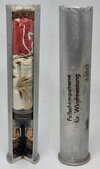 01 - Fallschirmpatrone fur windmessung.jpg941.8 KB · Views: 66
01 - Fallschirmpatrone fur windmessung.jpg941.8 KB · Views: 66 -
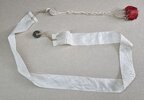 01A - parachute (red), ribbon and lead weights.jpg3.4 MB · Views: 47
01A - parachute (red), ribbon and lead weights.jpg3.4 MB · Views: 47 -
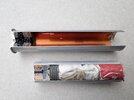 01B - Fallschirmpatrone für Windmessung projectile taken out.jpg2 MB · Views: 44
01B - Fallschirmpatrone für Windmessung projectile taken out.jpg2 MB · Views: 44 -
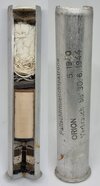 02 - Fallschirmleuchtpatrone.jpg1.2 MB · Views: 42
02 - Fallschirmleuchtpatrone.jpg1.2 MB · Views: 42 -
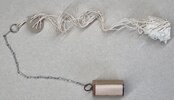 02A - lichtfakkel aan parachute.jpg911.1 KB · Views: 42
02A - lichtfakkel aan parachute.jpg911.1 KB · Views: 42 -
 03 - Fallschirmsignalpatrone Rot.jpg942.5 KB · Views: 41
03 - Fallschirmsignalpatrone Rot.jpg942.5 KB · Views: 41 -
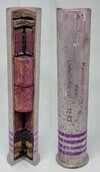 04 - Rauchbundelpatrone Violet.jpg982.3 KB · Views: 46
04 - Rauchbundelpatrone Violet.jpg982.3 KB · Views: 46 -
 05 - Sternbundelpatrone Rot-Grun mit gelben vorsignal.jpg1 MB · Views: 44
05 - Sternbundelpatrone Rot-Grun mit gelben vorsignal.jpg1 MB · Views: 44 -
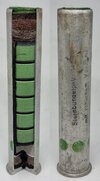 06 - Sernbundelpatrone grun 6.jpg997.1 KB · Views: 68
06 - Sernbundelpatrone grun 6.jpg997.1 KB · Views: 68
Last edited:


